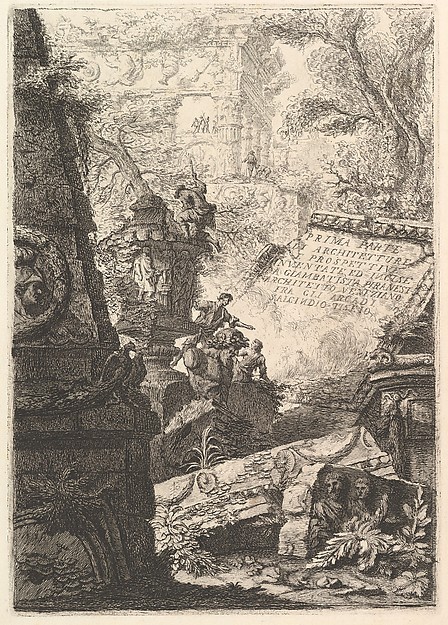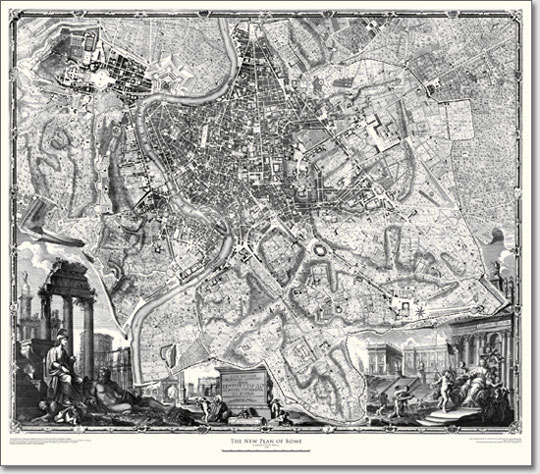Prima Parte di Architetture e Prospettive

Giovanni Battista Piranesi, Frontispiece: Prima Parte di Architetture e Prospettive, 1750, etching (Metropolitan Museum of Art)

Giovanni Battista Piranesi and Giambattista Nolli, Map of Rome, 1743, engraving (Architecture Grads)
Although Piranesi studied architecture in Venice, he never was able to find work in the field other than a few jobs involving remodeling in Rome.11 While Piranesi was struggling to support his architectural endeavors upon his arrival in Rome in 1740, he spent a short period of time in the studio of master painter Giovanni Battista Tiepolo (1696-1770) in addition to his apprenticeship with Giuseppe Vasi. The first production of Piranesi’s early years in Rome and a culmination of his training under Vasi, Tiepolo, and his uncle, was the Prima Parte di Architetture e Prospettive (1743). The Prima Parte was a collection of twelve etchings of imaginary temples, palaces, ruins, and a prison. During this time, Piranesi was still developing the unique style of etching he is known for today, and as such the Prima Parte differs significantly in technique compared to later works. In the Frontispiece of the Prima Parte, Piranesi’s lines are definite and exact with very little flow to them, designed in the form of traditional etching. The detail is immaculate, and yet perspective of the piece is oddly simple and familiar to the viewer. Piranesi’s technique employs miniscule markings and lines, intricately woven together to create a stippling effect. The Prima Parte, described as “rigid” by art historian Jonathan Scott, came to be seen as a stark contrast to his later sketches, which were much lighter and freer. Influenced by the style of Tiepolo, which epitomized the lightness and brightness of the Rococo period, Piranesi adopted some of the more painterly techniques of the masters he apprenticed under. Piranesi made the medium of etching appear as though it was a sketch or a painting, hence a “freer” and more fluid design in his later works. For example, the frontispiece of the Prima Parte read as an etching to Piranesi’s audience, but in his later vedute, the style of etching almost appears to be made of brushstrokes. Moreover, at the same time Piranesi was working on the Prima Parte, he aided the artist Giambattista Nolli.12 There is a small section of Nolli’s map of Rome, entitled La Topografia di Roma di Gio. Batt.a Nolli, etched in 1743 and attributed to Piranesi.13
_____________________________________________________________________________________
11Mayor, “Piranesi,” 281.
12Scott, Piranesi, 11-14.
13Mario Bevilacqua, Heather Hyde Minor, and Fabio Barry. "The Serpent and the Stylus: Essays on G. B. Piranesi," Memoirs of the American Academy in Rome, Supplementary Volumes 4 (2006): 8.